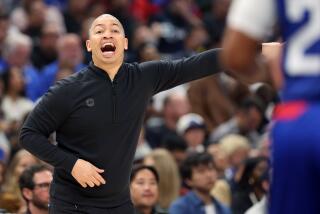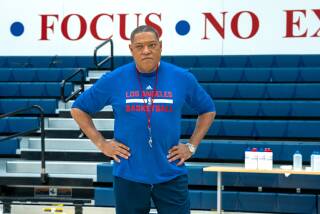Despite Defeat, Clippers No Longer a Punch Line
- Share via
PHOENIX — Amid a trail of three-pointers and a litany of nifty passes leading to easy baskets, the best season in Clippers’ history ended abruptly Monday night.
The Phoenix Suns defeated the Clippers, 127-107, at US Airways Center to win the NBA Western Conference semifinal series, four games to three. The Suns will play the Dallas Mavericks in the Western Conference finals beginning Wednesday.
The Suns’ trademark long-range shooting could not be stopped -- they made 15 of 27 shots from three-point range, continuing a trend in which they connected on a league-record 837 three-pointers during the regular season.
In the end, the Clippers met a fate similar to that of their city rivals, the Lakers, both falling by lopsided margins in playoff Game 7s against the Suns.
Of course, the Clippers were still playing Monday while the Lakers’ season had ended 17 days before, a fact not lost on long-suffering Clipper fans.
“They did a good job in this game; they played hard,” said Gal Ifrah, a 22-year-old from Reseda who watched the game with a small but vocal group of friends at a Woodland Hills bar. “What can I say? They went further than the Lakers.”
Whether the Clippers have turned the corner for good is debatable. Among some NBA observers there is hope; among others, skepticism.
Charles Barkley, a Hall of Fame player who is now a studio analyst for TNT’s NBA telecasts summed up the situation for many when he said Monday, “Getting to the Western Conference finals one time in 25 years doesn’t mean you’ve turned the corner. You haven’t even gone halfway down the block.”
That understood, this season’s success was unprecedented for the Clippers and owner Donald T. Sterling, whose Midas touch as a Beverly Hills developer had previously escaped his basketball team.
Since the Clippers moved to Los Angeles from San Diego in 1984, this is only their fourth playoffs series, and their winning percentage has hovered around .340, meaning they were losers in two of every three games.
But the Clippers were 47-35 during this regular season, their best record in L.A. and their second-best mark in the 36-year history of the franchise.
Clipper General Manager Elgin Baylor has amassed a talented young roster that has been shaped on the court by Coach Mike Dunleavy and rewarded financially by Sterling, who only recently cast aside his reputation as a miser.
Indeed, Sterling seemed not-just-happy-to-be-there in the final minutes of Game 7. Sitting stoically with his arms folded, he mostly stared straight ahead, his gaze breaking briefly at one point to accept a congratulatory handshake from actor Billy Crystal, one of the few celebrities to regularly follow the team.
His team’s turnaround can be traced to the summer of 2003, when Baylor made an unheralded center from Central Michigan University named Chris Kaman the No. 6 overall pick of the NBA draft. Then, within months, the Clippers signed up-and-coming power forward Elton Brand to an $82-million contract and gave Corey Maggette a deal worth $45 million.
The next summer, the Clippers raised more eyebrows by offering Kobe Bryant $100 million before he decided to re-sign with the Lakers.
Last summer, the Clippers’ trend to spend continued, with Cuttino Mobley given a $42-million contract -- making him the biggest free agent to come from another team -- and with Sam Cassell, a veteran guard who brought playoff experience and a healthy swagger, acquired in a trade.
Kaman, a blue-collar type in the mold Clippers fans have come to appreciate, has given the team a solid and steady 7-foot post presence; Brand, whose reputation is that of one of the league’s hardest workers and nicest guys, is now recognized among the game’s top forwards; Maggette gives the team a player who athletically matches up with anyone; Mobley has been a consistent scorer; and Cassell has shown a veteran’s penchant for making big shots in clutch situations.
The moves made Baylor, a Hall of Fame player with the Lakers but a long-suffering foil in his 20 years of calling Sterling’s shots with the Clippers, this season’s NBA executive of the year.
Whether the team can make that success last will be a prime topic for off-season debate.
For all their underdog appeal, the Clippers are still a distant No. 2 in a two-team NBA town, sharing the local turf with the NBA’s glamour franchise, the star-studded Lakers, winners of five league championships during the Magic Johnson-led Showtime era of the 1980s, and, more recently, three titles during the tumultuous Shaquille O’Neal-Kobe Bryant partnership.
Notoriety did find the Clippers. While the Lakers won championships, L.A.’s “other team” earned national headlines too -- for futility.
A Sports Illustrated story in 2000 called the Clippers’ “the most inept ever” in a study of professional sports franchises. The team also was routinely the butt of jokes, most notably by “Tonight Show” host Jay Leno who, in May two years ago, referred to national “Take Your Daughter to Work Day” as “a pretty embarrassing day” for the Clippers.
“They were going to take their daughters to work,” Leno quipped, “and then they realized, ‘Oh, it’s the playoffs. We never work during the playoffs.’ ”
The Clippers were even ridiculed by their highly paid employees.
Toward the end of the 1993-94 season, Ron Harper, a former NBA All-Star who was making $4 million, referred to his time with the Clippers as “just doing my jail time.”
Duke forward Danny Ferry, drafted by the Clippers with the No. 2 overall pick in 1989, opted to play in Italy rather than for the forlorn Clippers.
And then there was Benoit Benjamin, a 7-footer drafted with the No. 3 overall pick in 1985. He became the poster player for all that ailed the franchise during his 5 1/2 seasons with the Clippers.
Nicknamed “Big Ben,” he was a big bust, once infamously bringing two left shoes to an exhibition game. He temporarily hired outlandish boxing promoter Don King as his agent. He once sat out a game after suffering a bruised buttock, having rammed into a cabinet while maneuvering around his kitchen in the dark.
There have been other misadventures for the franchise.
Toward the end of the 1981-82 season, Sterling earned a $10,000 fine from the league by suggesting that his team lose as many games as possible down the stretch to clinch the No. 1 pick in the draft.
That was before the move to L.A. Since then, the Clippers have finished last in their division 11 times, including in 1986-87, when they were 12-70 and flirted with the Philadelphia 76ers’ record low of nine victories in a season.
When Staples Center opened in October 1999, the Lakers christened it eight months later with an NBA championship. The Clippers were 15-67 that season.
Before this season, the L.A. Clippers had made the playoffs in 1992 and 1993 during Larry Brown’s brief tenure as coach and in 1997 under Bill Fitch, who was fired a season later.
Coaches and players zipped through with barely a pause. The Clippers had 14 coaches from 1983 to 2003, before Dunleavy arrived, and the team never re-signed a player who became a free agent until Eric Piatkowski in 1999.
But for all that changeover and embarrassment, the future appears steady and bright.
Have these Clippers stemmed the tide for good?
There’s at least one indicator for optimism: As far as future splurging on player salaries, Sterling recently told The Times, “There is no shortage of money.”
And these words of caution from analyst Barkley: “They could be good the next couple of years. Kaman is really good; Brand is a stud. [But] if they don’t sign their guys, they’ll be back to being the old, cheap Clippers.”
Times staff writers Dan Loumena, in Los Angeles, and Mark Heisler, in Phoenix, contributed to this report.
More to Read
Go beyond the scoreboard
Get the latest on L.A.'s teams in the daily Sports Report newsletter.
You may occasionally receive promotional content from the Los Angeles Times.







